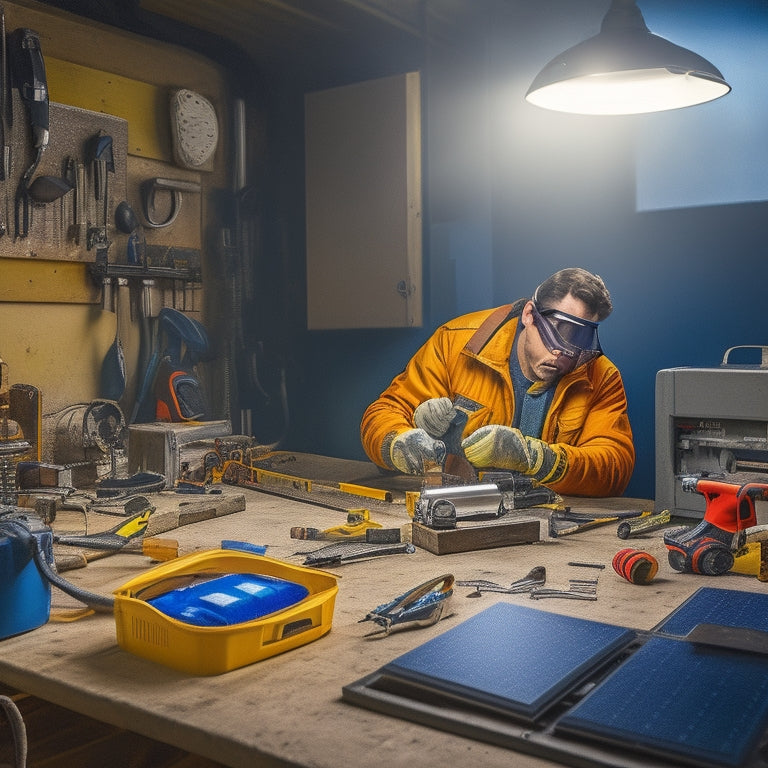
5 Tips for DIY Solar Battery Installation
Share
You'll want to start by evaluating your energy needs, calculating your total daily energy usage to determine the required battery capacity. Then, choose the right battery type and size, considering factors like chemistry, depth of discharge, and cycle life. Prepare your installation site by guaranteeing a safe and accessible area, clear of obstructions and electrical hazards. Next, connect your solar panels, following manufacturer's instructions for string configuration and inverter setup. Finally, monitor and maintain your system's performance, tracking energy production, battery state of charge, and system voltage to secure ideal results - and get ready to fine-tune your setup for maximum energy independence.
Key Takeaways
- Analyze energy consumption patterns to determine power storage requirements and calculate total daily energy needs for a reliable power supply.
- Choose the right battery by evaluating chemistry, depth of discharge, and cycle life, and prioritize installation safety with proper ventilation and connections.
- Prepare the installation site by clearing a safe area, ensuring unobstructed sunlight, and verifying structural soundness of the roof to support solar panels.
- Connect solar panels correctly by following manufacturer's instructions, integrating with inverter setup, and double-checking connections for security and compliance.
- Monitor and maintain performance by tracking energy production, monitoring battery state, measuring system voltage, and setting up system alerts for potential issues.
Assess Your Energy Needs
To determine the right solar battery installation for your needs, you must first calculate your energy requirements. This involves analyzing your energy consumption patterns to determine how much power you need to store.
Make a list of all the appliances and devices you want to power with your solar battery, including their wattage and usage hours. Add up their total energy consumption to get your daily energy needs. Accurate load calculation guarantees reliable power and customized system design energy profile.
Consider device efficiency and potential system losses in calculations. Next, consider your desired battery capacity, which should be sufficient to cover your energy needs during periods of low sunlight or at night.
A general rule of thumb is to oversize your battery capacity by 10-20% to account for unexpected energy usage.
Choose the Right Battery
Three key factors determine the suitability of a solar battery for your DIY installation: its chemistry, depth of discharge (DOD), and type.
You'll need to take these factors into account to guarantee a safe and efficient installation. Lead-acid, lithium-ion, and saltwater batteries are common types, each with its pros and cons.
Lead-acid batteries are cost-effective but heavy, while lithium-ion batteries are more efficient but expensive. Saltwater batteries offer a sustainable option.
The DOD indicates how much of the battery's capacity you can use safely. A higher DOD means more energy storage, but it also affects the battery's lifespan.
When choosing a battery, it's crucial to take into account the daily energy usage to determine the required capacity, and the cycle life of the battery, which ranges from 5 to 15 years based on quality and usage.
Prioritize installation safety by taking into consideration factors like ventilation, temperature range, and electrical connections.
Prepare Your Installation Site
Get your installation site ready by clearing a safe and accessible area for your solar battery setup. Confirm the site selection is free from obstructions, such as trees or buildings, which could cast shade on your solar panels.
Consider the proximity to your electrical panel and the route for the wiring. Take necessary safety precautions, like wearing protective gear and verifying the area is well-ventilated.
Check for any potential electrical hazards, such as exposed wires or outlets. Verify that the floor can support the weight of the batteries and equipment.
Additionally, consider the structural soundness of your roof roof structural integrity and confirm it can support the weight of the solar panels, as a sturdy roof is essential for a successful installation.
Connect Your Solar Panels
Connecting your solar panels marks an essential step in your DIY solar battery installation. You'll need to guarantee that your panel wiring is configured correctly to maximize energy production.
Start by connecting the positive and negative terminals of each panel to form a series string. Make sure to follow the manufacturer's instructions for the recommended string configuration.
Next, connect the series strings in parallel to achieve the desired voltage and current output. Finally, connect the output to your inverter setup, which will convert the DC power from your panels to AC power for your home.
Double-check your connections to verify they're secure and meet local electrical codes.
Monitor and Maintain Performance
Now that your solar panel array is up and running, you'll want to keep a close eye on its performance to guarantee you're maximizing your energy production. Monitoring your system's performance is vital for performance optimization. You'll need to track key metrics, such as energy production, battery state of charge, and system voltage.
| Metric | Why It Matters | How to Monitor |
|---|---|---|
| Energy Production | Verify your system is producing the expected amount of energy | Use a monitoring system or inverter with built-in monitoring |
| Battery State of Charge | Confirm your batteries are properly charged and maintained | Install a battery monitoring system |
| System Voltage | Identify potential electrical issues | Use a multimeter or monitoring system |
| Temperature | Optimize system performance and prevent overheating | Install temperature sensors |
| System Alerts | Receive notifications of system faults or issues | Set up system alerts through your monitoring system |
Frequently Asked Questions
Can I Install a DIY Solar Battery System With Existing Solar Panels?
Imagine upgrading your old smartphone with a new battery - it's similar with solar panels! You can install a DIY solar battery system with existing panels, but guarantee solar panel compatibility and select the right battery to maximize energy storage and efficiency.
Do I Need a Professional to Inspect My DIY Solar Battery Installation?
You should consider hiring a professional to inspect your DIY solar battery installation to guarantee compliance with safety regulations and adherence to installation guidelines, as they can identify potential risks and optimize system performance.
Are DIY Solar Battery Systems Compatible With Grid-Tie Inverters?
A million things can go wrong, but don't worry, you're on the right track! You're wondering if your DIY solar battery system is compatible with grid-tie inverters - the answer is yes, but be aware of inverter limitations and guarantee seamless grid tie compatibility.
Can I Use a DIY Solar Battery System for Emergency Power Backup?
You can use a DIY solar battery system for emergency power backup, ensuring power reliability during outages, and supporting emergency preparedness by storing excess energy generated during the day for nighttime or backup use.
Will a DIY Solar Battery System Affect My Home's Resale Value?
As you weigh the benefits of energy independence, you wonder if your DIY solar battery system will be a golden ticket or a deal-breaker for potential buyers, impacting your property appraisal and ultimately, your home's resale value.
Related Posts
-

Top Portable Refrigerators for Camping Adventures
When you're camping, having a reliable portable refrigerator can make all the difference for keeping your food fresh ...
-

The Future of Residential Energy Storage
The future of residential energy storage looks promising and cost-effective for you. With lithium-ion battery prices ...
-

Essential Hiking Lights for Safety and Fun
When you're hitting the trails, essential hiking lights are vital for safety and fun. A lightweight headlamp offers h...


